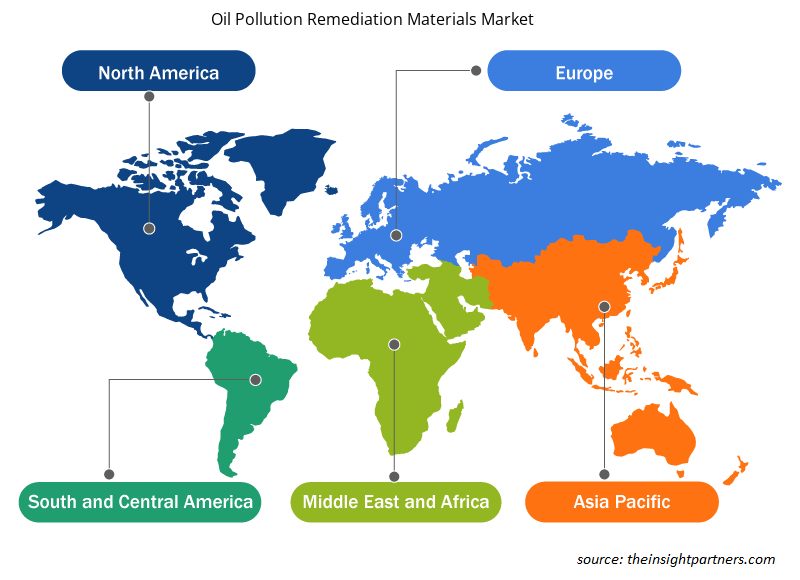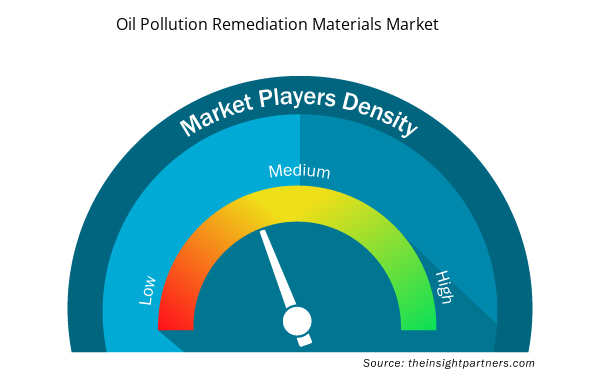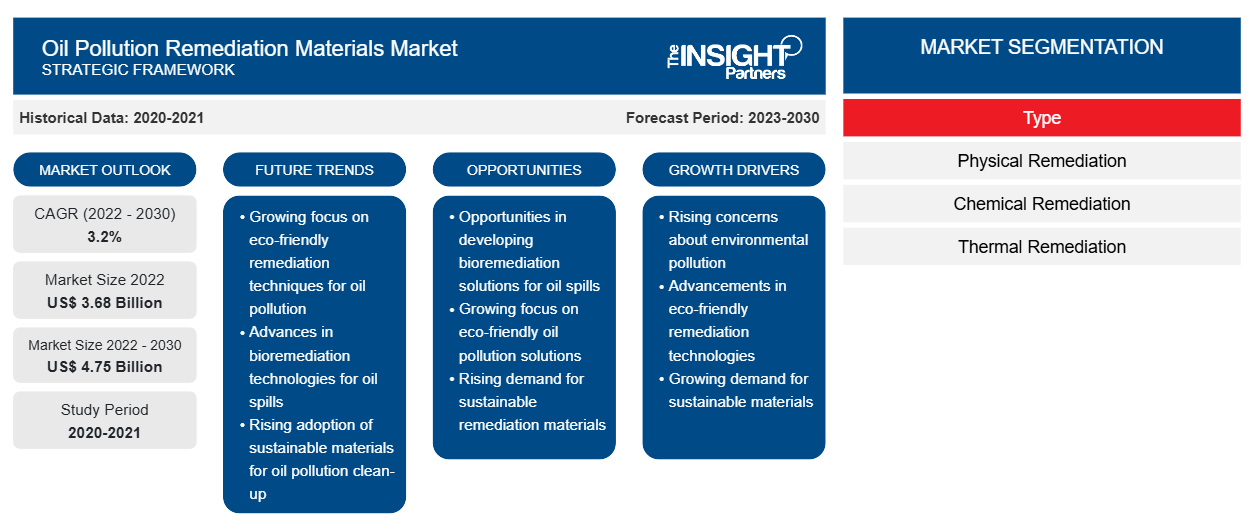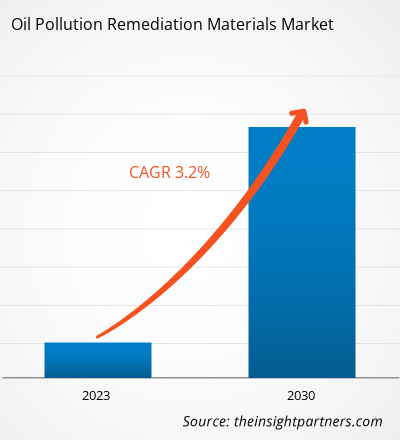[研究报告] 石油污染修复材料市场分析在2022年价值36.8436亿美元,预计到2030年将达到47.4956亿美元;预计2022年至2030年的复合年增长率为3.2%。
市场分析
石油污染修复材料用于降低全球范围内各种石油勘探、运输和工业运营活动对水体造成污染的高风险。修复技术主要分为物理修复、化学修复、热修复和生物修复。它们对于解决海洋石油泄漏问题极为重要。物理修复包括围油栏、撇油器和吸附剂等材料。化学修复材料包括分散剂和固化剂。
推动石油污染修复材料市场增长的主要因素是海上石油勘探和运输活动的增加以及与石油泄漏准备和响应相关的政府法规。过去几年中,各国政府都制定了石油泄漏清理法规,以确保迅速有效地应对环境紧急情况。这些法规通常概述了公司必须遵循的程序、技术和标准,以遏制、控制和清理石油泄漏。法规通常规定必须使用的修复材料类型,以最大限度地减少环境影响并确保有效清理。对有效石油泄漏清理的需求不断增长,推动了对修复材料的需求。
随着环境问题和法规的加强,人们越来越重视使用先进的环保材料进行修复。某些吸收剂、分散剂和屏障可能会被要求符合安全和功效标准,从而促进在石油泄漏应对工作中使用环保高效的材料。政府和石油行业都有准备计划,定期进行石油泄漏应对。政府要求及时处理石油泄漏,并尽量减少生态影响,这推动了对吸收剂、分散剂和其他修复材料的需求。2023 年,美国环境保护署根据联邦政府的国家应急计划 (NCP) 加强了标准,以改善美国水域和毗邻海岸线的石油泄漏应对工作。这些标准包括开发有效的石油泄漏修复产品,例如化学和生物制剂,并提供与使用这些产品相关的透明度和信息。
海上勘探和钻井活动的增加、通过管道或油轮运输石油以及石油开采和储存过程中的人为失误增加了发生漏油事件的可能性。根据国际能源署的数据,2021 年全球石油需求反弹,预计到 2025 年亚洲将占石油需求的 77%。预计到 2025 年亚洲的石油进口需求将超过每天 3100 万桶。亚太地区各国政府已启动石油项目,以满足该地区日益增长的石油需求。2023 年,马来西亚国家石油公司及其石油安排承包商报告了 19 个油气勘探发现和两次勘探评估成功,为马来西亚贡献了超过 10 亿桶油当量的新资源。这是过去几年加强勘探计划的结果,该计划共钻探了 25 口井。自 2015 年以来,这是单年钻探勘探井数量最多的一年。
增长动力与挑战
根据美国能源信息署2024年1月发布的报告,截至2024年1月9日,自新冠疫情爆发以来,美国原油产量有所增加,扭转了两年来的下滑趋势。美国原油产量从2021年的1127万桶/日上升至2023年的1321万桶/日,预计到2024年将达到1344万桶/日。根据加拿大能源监管机构的数据,加拿大生产的大部分原油通过西部省份的管道运输到美国、安大略省和魁北克省的炼油厂。根据布鲁盖尔AISBL 2023年发布的报告,俄罗斯是2021年全球五大能源生产国和消费国之一。同年,俄罗斯生产了5.952亿公吨原油,其中2.866亿公吨出口。因此,海上石油勘探和运输活动的增加推动了石油污染修复材料市场的发展。
定制此报告以满足您的需求
您可以免费定制任何报告,包括本报告的部分内容、国家级分析、Excel 数据包,以及为初创企业和大学提供优惠和折扣
- 获取此报告的关键市场趋势。这个免费样品将包括数据分析,从市场趋势到估计和预测。
石油污染修复材料市场区域洞察
Insight Partners 的分析师已详尽解释了预测期内影响石油污染修复材料市场的区域趋势和因素。本节还讨论了北美、欧洲、亚太地区、中东和非洲以及南美和中美洲的石油污染修复材料市场细分和地理位置。

- 获取石油污染修复材料市场的区域特定数据
石油污染修复材料市场报告范围
| 报告属性 | 细节 |
|---|---|
| 2022 年市场规模 | 36.8亿美元 |
| 2030 年的市场规模 | 47.5亿美元 |
| 全球复合年增长率(2022 - 2030 年) | 3.2% |
| 史料 | 2020-2021 |
| 预测期 | 2023-2030 |
| 涵盖的领域 | 按类型
|
| 覆盖地区和国家 | 北美
|
| 市场领导者和主要公司简介 |
|
石油污染修复材料市场参与者密度:了解其对业务动态的影响
石油污染修复材料市场正在快速增长,这得益于最终用户需求的不断增长,这些需求源于消费者偏好的不断变化、技术进步以及对产品优势的认识不断提高等因素。随着需求的增加,企业正在扩大其产品范围,进行创新以满足消费者的需求,并利用新兴趋势,从而进一步推动市场增长。
市场参与者密度是指在特定市场或行业内运营的企业或公司的分布情况。它表明在给定市场空间中,相对于其规模或总市场价值,有多少竞争对手(市场参与者)存在。
在石油污染修复材料市场运营的主要公司有:
- Sarva Bio Remed 有限责任公司
- 石油技术有限公司
免责声明:上面列出的公司没有按照任何特定顺序排列。

- 获取石油污染修复材料市场顶级关键参与者概述
竞争格局和重点公司
Sarva Bio Remed LLC、Oil Technics Ltd、Ansell Ltd、Oil-Dri Corp of America、Verde Environmental Group Ltd、Ecolab Inc、Cosco Shipping Heavy Industry Co Ltd、Regenesis、TOLSA SA 和 CL Solutions LLC 是石油污染修复材料市场报告中介绍的知名企业。此外,在研究过程中还研究和分析了其他几家企业,以全面了解市场及其生态系统。石油污染修复材料市场报告还包括公司定位和集中度,以评估竞争对手/市场参与者的表现。
行业发展和未来机遇
以下列举了石油污染修复材料市场的主要参与者所采取的举措:
2022 年 11 月,Ansell Ltd 在印度的绿地制造工厂投资约 8000 万美元。
- 历史分析(2 年)、基准年、预测(7 年)及复合年增长率
- PEST 和 SWOT 分析
- 市场规模价值/数量 - 全球、区域、国家
- 行业和竞争格局
- Excel 数据集



Report Coverage
Revenue forecast, Company Analysis, Industry landscape, Growth factors, and Trends

Segment Covered
This text is related
to segments covered.

Regional Scope
North America, Europe, Asia Pacific, Middle East & Africa, South & Central America

Country Scope
This text is related
to country scope.
常见问题
The major players operating in the global oil pollution remediation materials market are Sarva Bio Remed LLC, Oil Technics Ltd, Ansell Ltd, Oil-Dri Corp of America, Verde Environmental Group Ltd, Ecolab Inc, Cosco Shipping Heavy Industry Co Ltd, Regenesis, TOLSA SA, CL Solutions LLC, Procon Environmental Technologies (Pty) Ltd, Brady Corp, Oil Spill Eater International Corp, Osprey Spill Control, NOV Inc, Fender & Spill Response Services LLC, RX Marine International, Cura Inc, Compania Espanola de Petroleos SA, and SkimOIL LLC.
Rising awareness of environmental issues across the world has led to an emphasis on sustainable practices. Stringent environmental regulations and compliance standards have prompted companies to adopt clean and environment-friendly practices. Companies and governments seek remediation solutions that minimize ecological impact. Thus, market players offering eco-friendly solutions for oil spill cleanup are likely to attract a large customer base and gain favor with regulatory bodies. This demand for eco-friendly solutions aligns with global efforts to mitigate the impact of pollution and support the development of green technologies.
Middle East & Africa accounted for the largest share of the global oil pollution remediation materials market. The Middle East & Africa is home to major crude oil reserves; the number of crude oil exploration activities has surged notably in this region in the past few years. Developments in technologies that aid in oil exploration and production operations have propelled the risk of oil spills, driving the demand for oil pollution remediation materials and services.
Based on type, the oil pollution remediation materials market is segmented into physical remediation (booms, skimmers, and adsorbent materials), chemical remediation (dispersants and solidifiers), thermal remediation, and bioremediation. Physical remediation is commonly used to control oil spills in a water environment. It is used to contain and recover oil that remains on the water surface without changing its properties. It is also mainly used as a barrier to control the spreading of oil spills without changing its physical and chemical characteristics.
Increased offshore exploration and drilling activities, transportation of oil via pipelines or tankers, and human errors during oil extraction and storage propel the chances of oil spill incidences. According to the International Energy Agency, the global oil demand rebounded in 2021, and Asia is expected to account for 77% of oil demand by 2025. Asia’s oil import requirements are expected to surpass 31 million barrels per day by 2025. Governments of various countries in Asia Pacific have initiated oil projects to cater to the rising demand for oil in the region.
Based on type, the bioremediation segment is expected to grow fastest during the forecast period. Bioremediation involves the use of additives to accelerate biodegradation, a natural process in which microorganisms break down complex compounds into simpler products to obtain energy and nutrients. Biostimulation and bioaugmentation are two widely used bioremediation approaches.
Trends and growth analysis reports related to Chemicals and Materials : READ MORE..
The List of Companies - Oil Pollution Remediation Materials Market
- Sarva Bio Remed LLC
- Oil Technics Ltd
- Ansell Ltd
- Oil-Dri Corp of America
- Verde Environmental Group Ltd
- Ecolab Inc
- Cosco Shipping Heavy Industry Co Ltd
- Regenesis
- TOLSA SA
- CL Solutions LLC
The Insight Partners performs research in 4 major stages: Data Collection & Secondary Research, Primary Research, Data Analysis and Data Triangulation & Final Review.
- Data Collection and Secondary Research:
As a market research and consulting firm operating from a decade, we have published and advised several client across the globe. First step for any study will start with an assessment of currently available data and insights from existing reports. Further, historical and current market information is collected from Investor Presentations, Annual Reports, SEC Filings, etc., and other information related to company’s performance and market positioning are gathered from Paid Databases (Factiva, Hoovers, and Reuters) and various other publications available in public domain.
Several associations trade associates, technical forums, institutes, societies and organization are accessed to gain technical as well as market related insights through their publications such as research papers, blogs and press releases related to the studies are referred to get cues about the market. Further, white papers, journals, magazines, and other news articles published in last 3 years are scrutinized and analyzed to understand the current market trends.
- Primary Research:
The primarily interview analysis comprise of data obtained from industry participants interview and answers to survey questions gathered by in-house primary team.
For primary research, interviews are conducted with industry experts/CEOs/Marketing Managers/VPs/Subject Matter Experts from both demand and supply side to get a 360-degree view of the market. The primary team conducts several interviews based on the complexity of the markets to understand the various market trends and dynamics which makes research more credible and precise.
A typical research interview fulfils the following functions:
- Provides first-hand information on the market size, market trends, growth trends, competitive landscape, and outlook
- Validates and strengthens in-house secondary research findings
- Develops the analysis team’s expertise and market understanding
Primary research involves email interactions and telephone interviews for each market, category, segment, and sub-segment across geographies. The participants who typically take part in such a process include, but are not limited to:
- Industry participants: VPs, business development managers, market intelligence managers and national sales managers
- Outside experts: Valuation experts, research analysts and key opinion leaders specializing in the electronics and semiconductor industry.
Below is the breakup of our primary respondents by company, designation, and region:

Once we receive the confirmation from primary research sources or primary respondents, we finalize the base year market estimation and forecast the data as per the macroeconomic and microeconomic factors assessed during data collection.
- Data Analysis:
Once data is validated through both secondary as well as primary respondents, we finalize the market estimations by hypothesis formulation and factor analysis at regional and country level.
- Macro-Economic Factor Analysis:
We analyse macroeconomic indicators such the gross domestic product (GDP), increase in the demand for goods and services across industries, technological advancement, regional economic growth, governmental policies, the influence of COVID-19, PEST analysis, and other aspects. This analysis aids in setting benchmarks for various nations/regions and approximating market splits. Additionally, the general trend of the aforementioned components aid in determining the market's development possibilities.
- Country Level Data:
Various factors that are especially aligned to the country are taken into account to determine the market size for a certain area and country, including the presence of vendors, such as headquarters and offices, the country's GDP, demand patterns, and industry growth. To comprehend the market dynamics for the nation, a number of growth variables, inhibitors, application areas, and current market trends are researched. The aforementioned elements aid in determining the country's overall market's growth potential.
- Company Profile:
The “Table of Contents” is formulated by listing and analyzing more than 25 - 30 companies operating in the market ecosystem across geographies. However, we profile only 10 companies as a standard practice in our syndicate reports. These 10 companies comprise leading, emerging, and regional players. Nonetheless, our analysis is not restricted to the 10 listed companies, we also analyze other companies present in the market to develop a holistic view and understand the prevailing trends. The “Company Profiles” section in the report covers key facts, business description, products & services, financial information, SWOT analysis, and key developments. The financial information presented is extracted from the annual reports and official documents of the publicly listed companies. Upon collecting the information for the sections of respective companies, we verify them via various primary sources and then compile the data in respective company profiles. The company level information helps us in deriving the base number as well as in forecasting the market size.
- Developing Base Number:
Aggregation of sales statistics (2020-2022) and macro-economic factor, and other secondary and primary research insights are utilized to arrive at base number and related market shares for 2022. The data gaps are identified in this step and relevant market data is analyzed, collected from paid primary interviews or databases. On finalizing the base year market size, forecasts are developed on the basis of macro-economic, industry and market growth factors and company level analysis.
- Data Triangulation and Final Review:
The market findings and base year market size calculations are validated from supply as well as demand side. Demand side validations are based on macro-economic factor analysis and benchmarks for respective regions and countries. In case of supply side validations, revenues of major companies are estimated (in case not available) based on industry benchmark, approximate number of employees, product portfolio, and primary interviews revenues are gathered. Further revenue from target product/service segment is assessed to avoid overshooting of market statistics. In case of heavy deviations between supply and demand side values, all thes steps are repeated to achieve synchronization.
We follow an iterative model, wherein we share our research findings with Subject Matter Experts (SME’s) and Key Opinion Leaders (KOLs) until consensus view of the market is not formulated – this model negates any drastic deviation in the opinions of experts. Only validated and universally acceptable research findings are quoted in our reports.
We have important check points that we use to validate our research findings – which we call – data triangulation, where we validate the information, we generate from secondary sources with primary interviews and then we re-validate with our internal data bases and Subject matter experts. This comprehensive model enables us to deliver high quality, reliable data in shortest possible time.


 获取此报告的免费样本
获取此报告的免费样本